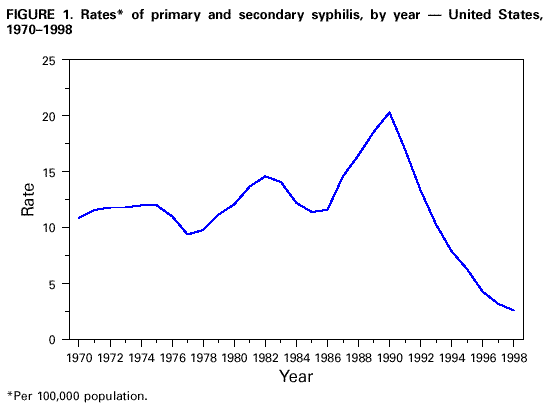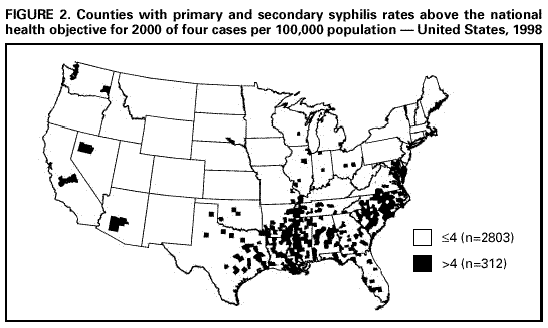 |
|
|
|
|
|
|
| ||||||||||
|
|
|
|
|
|
|
||||
| ||||||||||
|
|
|
|
|
Persons using assistive technology might not be able to fully access information in this file. For assistance, please send e-mail to: mmwrq@cdc.gov. Type 508 Accommodation and the title of the report in the subject line of e-mail. Primary and Secondary Syphilis -- United States, 1998Rates of primary and secondary (P&S) syphilis have been declining in the United States since the last national epidemic in 1990 (Figure 1) (1). Syphilis causes substantial morbidity and mortality in the form of cardiac and neurologic disease, stillbirth and developmental disability from congenital syphilis, and by facilitating transmission of human immunodeficiency virus (2,3). Syphilis is both preventable and curable and has been successfully controlled in most developed countries (4). In the United States, declines in P&S syphilis have been followed by epidemics occurring approximately every 7-10 years. During 1960-1990, these cyclical epidemics resulted in progressively higher peaks in morbidity (5). To evaluate the epidemiology of syphilis in the United States, CDC analyzed notifiable disease surveillance data for 1998. This report summarizes the results of that analysis, which indicate that in 1998 P&S syphilis declined to the lowest rates ever reported in the United States and that syphilis transmission increasingly is concentrated in fewer geographic areas. Summary data for syphilis cases reported to state health departments and the District of Columbia for 1998 were sent quarterly and annually to CDC. These data included the total number of syphilis cases by county of residence, sex, stage of disease, racial/ethnic group, and 5-year age group. Data on reported cases of P&S syphilis were analyzed for this report because these cases best represent incidence (i.e., newly acquired infections within the evaluated time). P&S syphilis rates were calculated per 100,000 persons using population denominators from the Bureau of the Census (5). In 1998, 6993 cases of P&S syphilis were reported in the United States (rate: 2.6 cases per 100,000 population), representing a 19% decrease in cases reported in 1997 (rate: 3.2) and an 86% decrease from the 50,578 cases reported in 1990 (rate: 20.3), the peak of the most recent U.S. epidemic (5) (Figure 1). In 1998, the rate of P&S syphilis was higher in the South (5.1) than in the Midwest (1.9), West (1.0), and Northeast (0.8); the rate of decline from 1997 to 1998 was greater in the Northeast (27%) than in the South (22%), Midwest (3%), and West (0%).* The rate of P&S syphilis was higher in blacks (17.1) than in American Indians/Alaska Natives (2.8), Hispanics (1.5), non-Hispanic whites (0.5), and Asians/Pacific Islanders (0.4). In 1998, the rate ratio of P&S syphilis in non-Hispanic blacks compared with non-Hispanic whites was 34:1, which is substantially lower than 44:1 in 1997 and 53:1 in 1990. Rates for P&S syphilis were 30% higher in men than in women in 1998. The incidence of P&S syphilis was highest among women aged 20-24 years and among men aged 30-39 years. During 1997-1998, the number of P&S syphilis cases declined or remained the same in 35 states and the District of Columbia (Table 1). The number of cases increased in 15 states; seven of these states are in the West. Although the absolute number of cases in the West was low, increases in Arizona and Washington were notable. Three other states reported substantial increases from 1997 to 1998: Louisiana, Indiana, and Michigan. Forty states had rates of P&S syphilis below 4.0, the target rate of the national health objectives for 2000 (objective 19.3) (5). Fourteen states reported five or fewer cases of syphilis. In 1998, 28 (0.9%) of 3115 counties accounted for 50% of P&S syphilis cases (Table 2), a 10% decrease from 31 counties in 1997. The South was disproportionately represented in the counties with the highest number of cases (19 of 28 counties). Counties/cities with the highest number of cases were Baltimore, Maryland; Cook County, Illinois (Chicago); Shelby County, Tennessee (Memphis); and Davidson County, Tennessee (Nashville). In 1998, 10 of the 28 counties had an increase in cases of P&S syphilis. Counties with the greatest percentage increase in cases were MarionCounty, Indiana (Indianapolis), Mecklenberg County, North Carolina (Charlotte), Maricopa County, Arizona (Phoenix), and Wayne County, Michigan (Detroit). In 1998, 2803 (90%) counties had rates of P&S syphilis equal to or below the 2000 national objective (Figure 2). In 1998, the number of counties reporting no cases of P&S syphilis increased to 2430 (78%) from 2324 (75%) in 1997. Reported by: State and local health depts. Epidemiology and Surveillance Br, Statistics and Data Management Br, Div of Sexually Transmitted Diseases Prevention, National Center for HIV, STD, and TB Prevention, CDC. Editorial Note:The number and rate of P&S syphilis cases reported in 1998 in the United States are record lows. Syphilis is progressively concentrated geographically; in 1998, 50% of P&S syphilis cases occurred in fewer counties than in 1997, and the number of cases in most of those counties declined in 1998. In 1998, approximately 80% of U.S. counties reported no infectious syphilis. Despite progress in syphilis control nationally, increases have occurred in several states and local areas. Focal outbreaks have occurred in both Marion County, Indiana (Indianapolis) (associated with exchanging sex for drugs or money), and King County, Washington (Seattle) (associated with increases in cases among men who have sex with men) (6,7). The variation in demographics over time and between regions highlights the importance of analyzing demographic and behavioral information and developing targeted interventions. Despite considerable declines in syphilis rates, continued attention must focus on educating and screening persons in settings associated with high-risk behaviors, maintaining high quality surveillance systems, and recognizing changing demographics. The findings in this report are subject to at least three limitations. First, the quality of surveillance varies at the local and state levels. Second, sexually transmitted disease (STD) reporting may be incomplete. Finally, reporting of syphilis may be biased toward overreporting of infections in persons of minority race/ethnicity who attend public STD clinics. The degree to which this bias influences reported rates of syphilis is unknown. Syphilis results in severe health consequences with substantial social and economic cost. National annual direct and indirect costs of syphilis are an estimated $966 million (8). The low rates of P&S syphilis, the geographic concentration of infection, and the potential for another large-scale epidemic underscore the importance of initiating an effective elimination campaign (4). CDC, in collaboration with Health Resources and Services Administration, Substance Abuse and Mental Health Services Administration, the National Institutes and Health, the National Institute of Justice, and partners in state and local health departments, community-based organizations, and researchers, has developed a National Plan for Elimination of Syphilis from the United States (9). The five key strategies of the plan focus on enhanced community involvement and partnerships at local, state, and national levels, intensified surveillance, rapid outbreak response, expanded access to health care for those infected or exposed to syphilis, and improved health promotion. Syphilis elimination in the United States has been defined as the absence of sustained transmission. The national goal for syphilis elimination is to reduce P&S syphilis cases to less than 1000 (rate: 0.4 per 100,000 population) and to increase the number of syphilis-free counties to 90% by 2005. Syphilis elimination can be the entry point for building or rebuilding broader public health capacity to control infectious disease and to assure reproductive health in historically underserved communities (10). References
* Northeast=Connecticut, Maine, Massachusetts, New Hampshire, New Jersey, New York, Pennsylvania, Rhode Island, and Vermont; Midwest=Illinois, Indiana, Iowa, Kansas, Michigan, Minnesota, Missouri, Nebraska, North Dakota, Ohio, South Dakota, and Wisconsin; South =Alabama, Arkansas, Delaware, District of Columbia, Florida, Georgia, Kentucky, Louisiana, Maryland, Mississippi, North Carolina, Oklahoma, South Carolina, Tennessee, Texas, Virginia, and West Virginia; and West=Alaska, Arizona, California, Colorado, Hawaii, Idaho, Montana, Nevada, New Mexico, Oregon, Utah, Washington, and Wyoming. Table 1 Note: To print large tables and graphs users may have to change their printer settings to landscape and use a small font size. TABLE 1. Reported primary and secondary syphilis cases, by state and percentage change, from 1997 to 1998 -- United States
* Percentage change not calculated for states with fewer than five cases. Return to top. Figure 1  Return to top. Table 2 Note: To print large tables and graphs users may have to change their printer settings to landscape and use a small font size. TABLE 2. Reported primary and secondary syphilis cases, by county and percentage change, from 1997 to 1998 -- United States
* Independent city. Return to top. Figure 2  Return to top. Disclaimer All MMWR HTML versions of articles are electronic conversions from ASCII text into HTML. This conversion may have resulted in character translation or format errors in the HTML version. Users should not rely on this HTML document, but are referred to the electronic PDF version and/or the original MMWR paper copy for the official text, figures, and tables. An original paper copy of this issue can be obtained from the Superintendent of Documents, U.S. Government Printing Office (GPO), Washington, DC 20402-9371; telephone: (202) 512-1800. Contact GPO for current prices. **Questions or messages regarding errors in formatting should be addressed to mmwrq@cdc.gov.Page converted: 10/7/1999 |
||||||||||||||||||||||||||||||||||||||||||||||||||||||||||||||||||||||||||||||||||||||||||||||||||||||||||||||||||||||||||||||||||||||||||||||||||||||||||||||||||||||||||||||||||||||||||||||||||||||||||||||||||||||||||||||||||||||||||||||||||||||||||||||||||||||||||||||||||||||||||||||||||||||||||||||||||||||||||||||||||||||||||||||
This page last reviewed 5/2/01
|